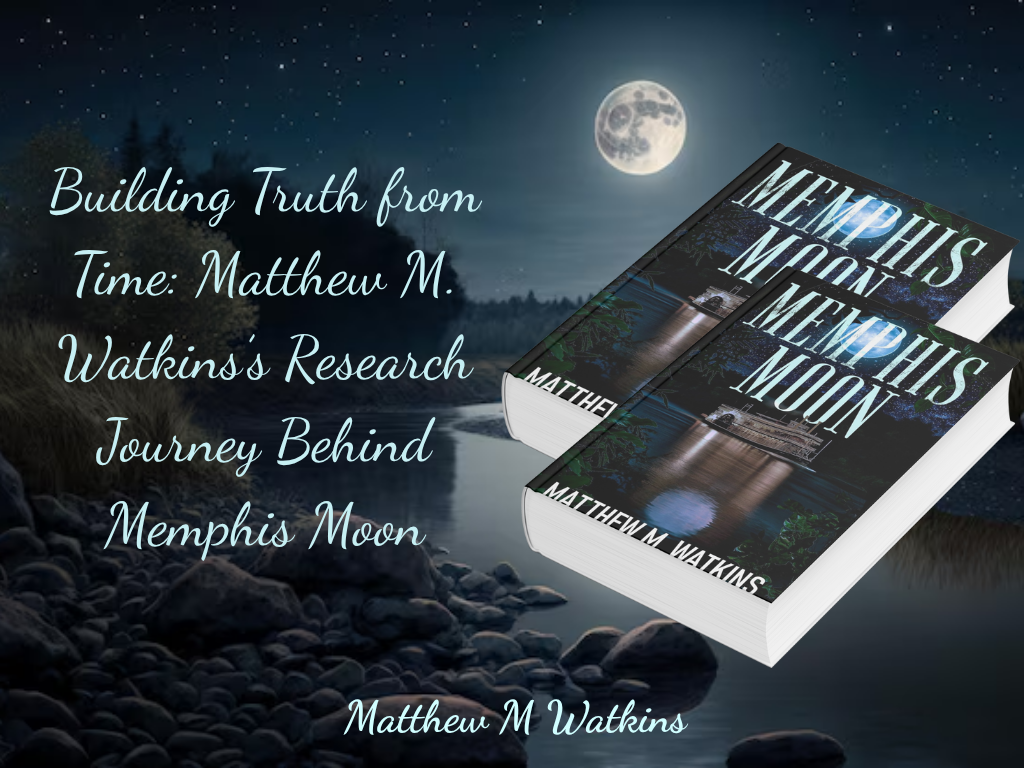Before a single line of Memphis Moon was written, Matthew M. Watkins was already deep in another kind of storytelling, the quiet, disciplined work of research. His ability to make the nineteenth-century South feel lived-in doesn’t come from imagination alone; it comes from years of listening to the past until it began to answer back.
Watkins’s creative process has always leaned toward immersion. In interviews and press notes, he describes how his fascination with the Moon sisters, Virginia “Ginnie” Bethel Moon and Charlotte “Lottie” Moon, began not with their notoriety, but with the small fragments of history left behind: letters, missionary reports, and regional archives that hinted at entire emotional worlds between the lines. He read deeply into those sources, piecing together gestures and motivations that official biographies never touched.
From those fragments, Watkins began to build Memphis Moon. He wasn’t interested in writing a “Civil War novel” in the traditional sense, one about generals and battlefields. His focus was always on how ordinary people experienced extraordinary times. To get there, his research reached far beyond textbooks. He examined old maps of Virginia’s tobacco country, studied millwork and agricultural life, and even noted the dialect and rhythms of Southern speech drawn from regional newspapers of the era.
The result is a narrative grounded in historical authenticity yet alive with emotional immediacy. When readers step into Danville, Virginia, the heartbeat of Memphis Moon, they don’t feel as though they’re visiting a museum. They feel as though they’re walking down its streets, hearing wagon wheels rattle on clay, and smelling the dust that rises from the millrace. Watkins’s realism comes not from the quantity of details, but from how carefully they’ve been chosen.
He’s often said that history’s job is to record events, but a novelist’s job is to recover experience. That belief shapes every aspect of his writing. Watkins treats the past as something tactile, a place where sensory precision unlocks empathy. The soft creak of a church pew, the smell of rain on a cotton field, the way grief folds into silence, all of these come from his deep engagement with firsthand accounts and period documents.
The author’s background as both a journalist and a musician contributes to that authenticity. Journalism taught him how to chase facts and honor accuracy; music taught him rhythm and restraint. Together, those sensibilities keep his prose anchored yet lyrical. He approaches dialogue like a score, listening for cadences that sound true to the century without slipping into caricature.
His portrayal of the Civil War itself reflects the same disciplined honesty. Watkins avoids both sentimentality and revisionism. He neither glorifies the conflict nor flattens it into moral simplicity. Instead, he writes about people caught in its current, farmers, millers, sisters, soldiers, each making choices that feel painfully human. That realism owes much to his careful reading of diaries and letters written by civilians of the period, many of whom expressed contradictions that mirror those of his own characters.
What’s remarkable is how Watkins transforms research into empathy. Facts, for him, are not trophies; they’re doorways. He uses them to enter the minds of his characters, to imagine what it felt like to live in a world where loyalty and love could be at odds. His pages are filled with the small truths that only appear when a writer truly believes in his subjects, a habit of thought that turns scholarship into art.
Even in the modern-day section of Memphis Moon, you can see the tone carry the weight of the research. The rediscovered diary that helps anchor the plot feels vivid and real because Watkins builds the book from authentic linguistic patterns. The entries of the diary feel like actual, genuine confessions that are shaped by a woman’s understanding of what war and duty are in 1863. It is this attention to authenticity and truth that allows the readers to forget they’re reading fiction at all.
In the featured article, Watkins reflected that writing historical fiction means “learning when to disappear.” The goal, he said, isn’t to impress readers with what you’ve learned; it’s to make them forget you learned it at all. That philosophy explains why Memphis Moon flows so effortlessly between history and heart. Every researched detail serves emotion; none exists to show off accuracy.
And yet, for all the hours spent in archives and libraries, Watkins’s most important research took place in empathy, in asking himself how forgiveness, faith, and survival would feel to people standing on both sides of a divided world. The facts gave him structure. The feelings gave him truth.
By the time Memphis Moon was finished, the research had become invisible, absorbed into the fabric of the story, like ink soaked into old paper. What remains on the page is what Watkins set out to find from the beginning: not a reconstruction of history, but a resurrection of humanity.

